Discretion in Sentencing: An Analysis of the Criminal Justice System
VerifiedAdded on 2023/06/11
|8
|2109
|237
Essay
AI Summary
This essay critically examines the role of discretion in sentencing within the Australian criminal justice system, focusing on its application during investigation, pretrial, sentencing, and punishment phases. It discusses the balance between judicial discretion and parliamentary law, highlighting instances where compulsory sentencing limits discretionary power. The essay analyzes the impact of aggravating and mitigating factors, as well as victim impact statements, on sentencing decisions, referencing relevant case law such as R v Dean [2013] NSWSC 1027 and McCartney v R (2009) NSWCCA 244. It also explores the challenges and criticisms of discretionary sentencing, including concerns about consistency and fairness, and the influence of sentencing guidelines. Furthermore, the essay considers how discretionary decisions at early stages of the criminal justice system affect later stages, such as plea bargains and parole considerations, ultimately arguing for the need to reform the use of discretion to ensure fairer outcomes.
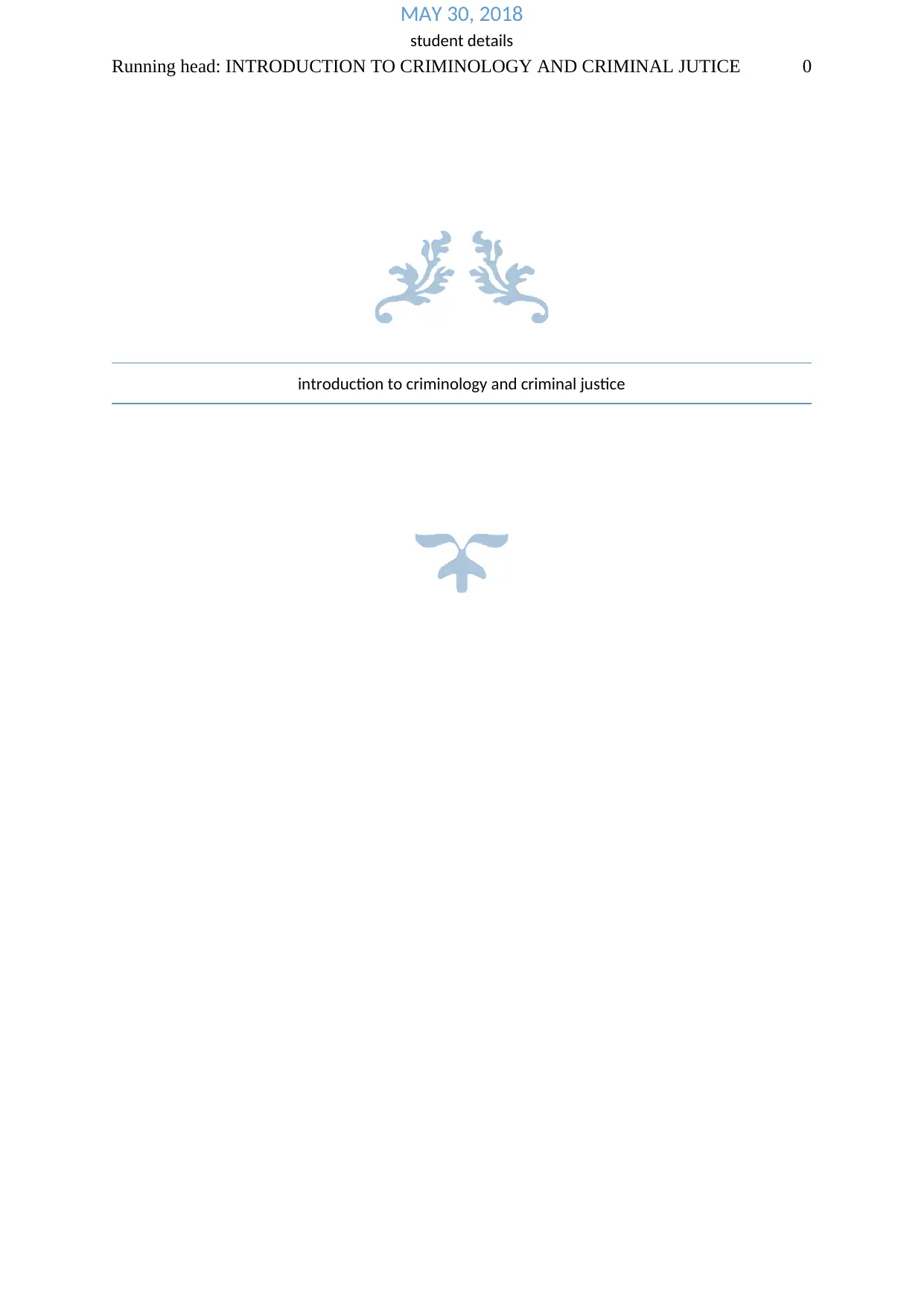
Running head: INTRODUCTION TO CRIMINOLOGY AND CRIMINAL JUTICE 0
introduction to criminology and criminal justice
MAY 30, 2018
student details
introduction to criminology and criminal justice
MAY 30, 2018
student details
Paraphrase This Document
Need a fresh take? Get an instant paraphrase of this document with our AI Paraphraser
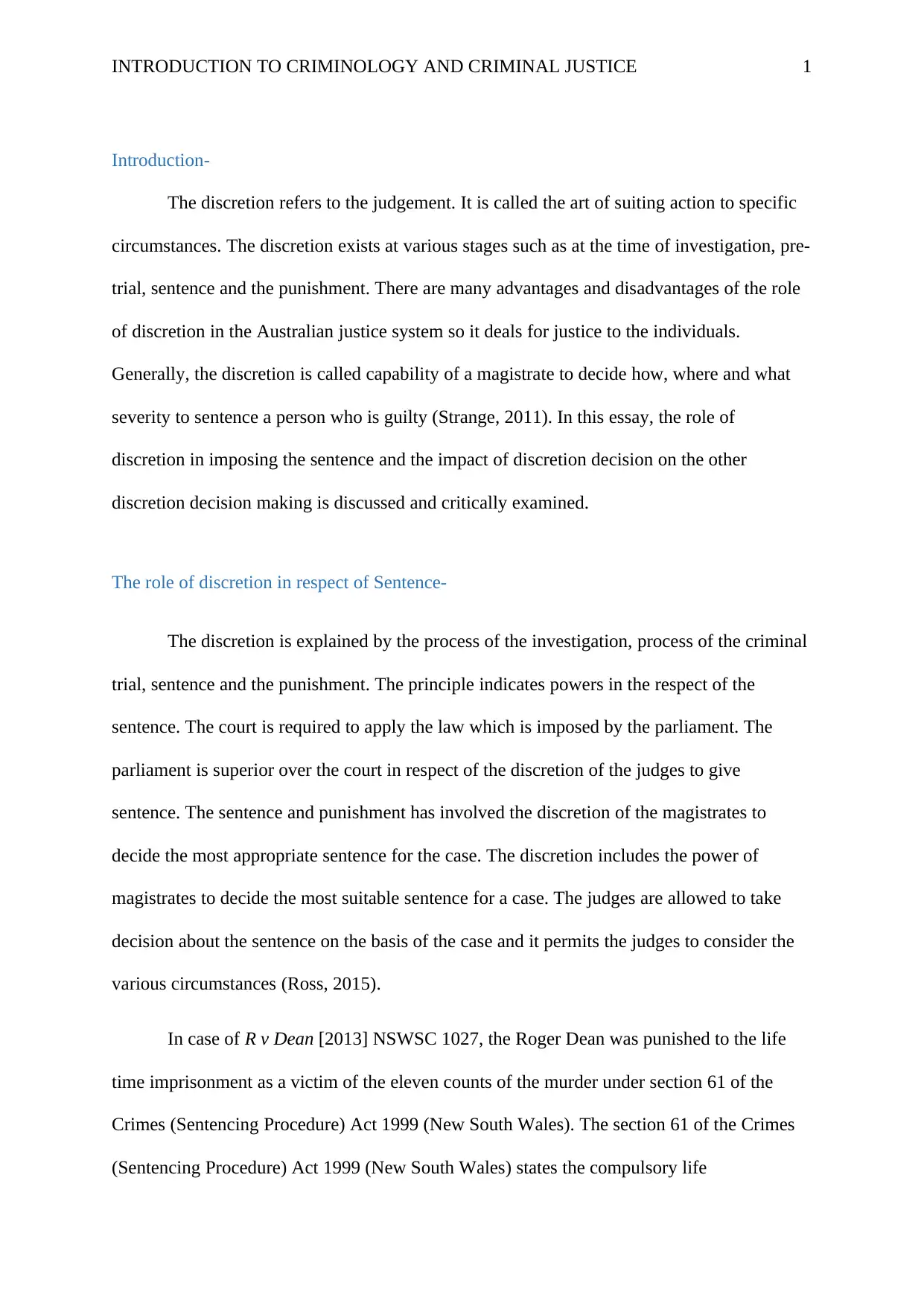
INTRODUCTION TO CRIMINOLOGY AND CRIMINAL JUSTICE 1
Introduction-
The discretion refers to the judgement. It is called the art of suiting action to specific
circumstances. The discretion exists at various stages such as at the time of investigation, pre-
trial, sentence and the punishment. There are many advantages and disadvantages of the role
of discretion in the Australian justice system so it deals for justice to the individuals.
Generally, the discretion is called capability of a magistrate to decide how, where and what
severity to sentence a person who is guilty (Strange, 2011). In this essay, the role of
discretion in imposing the sentence and the impact of discretion decision on the other
discretion decision making is discussed and critically examined.
The role of discretion in respect of Sentence-
The discretion is explained by the process of the investigation, process of the criminal
trial, sentence and the punishment. The principle indicates powers in the respect of the
sentence. The court is required to apply the law which is imposed by the parliament. The
parliament is superior over the court in respect of the discretion of the judges to give
sentence. The sentence and punishment has involved the discretion of the magistrates to
decide the most appropriate sentence for the case. The discretion includes the power of
magistrates to decide the most suitable sentence for a case. The judges are allowed to take
decision about the sentence on the basis of the case and it permits the judges to consider the
various circumstances (Ross, 2015).
In case of R v Dean [2013] NSWSC 1027, the Roger Dean was punished to the life
time imprisonment as a victim of the eleven counts of the murder under section 61 of the
Crimes (Sentencing Procedure) Act 1999 (New South Wales). The section 61 of the Crimes
(Sentencing Procedure) Act 1999 (New South Wales) states the compulsory life
Introduction-
The discretion refers to the judgement. It is called the art of suiting action to specific
circumstances. The discretion exists at various stages such as at the time of investigation, pre-
trial, sentence and the punishment. There are many advantages and disadvantages of the role
of discretion in the Australian justice system so it deals for justice to the individuals.
Generally, the discretion is called capability of a magistrate to decide how, where and what
severity to sentence a person who is guilty (Strange, 2011). In this essay, the role of
discretion in imposing the sentence and the impact of discretion decision on the other
discretion decision making is discussed and critically examined.
The role of discretion in respect of Sentence-
The discretion is explained by the process of the investigation, process of the criminal
trial, sentence and the punishment. The principle indicates powers in the respect of the
sentence. The court is required to apply the law which is imposed by the parliament. The
parliament is superior over the court in respect of the discretion of the judges to give
sentence. The sentence and punishment has involved the discretion of the magistrates to
decide the most appropriate sentence for the case. The discretion includes the power of
magistrates to decide the most suitable sentence for a case. The judges are allowed to take
decision about the sentence on the basis of the case and it permits the judges to consider the
various circumstances (Ross, 2015).
In case of R v Dean [2013] NSWSC 1027, the Roger Dean was punished to the life
time imprisonment as a victim of the eleven counts of the murder under section 61 of the
Crimes (Sentencing Procedure) Act 1999 (New South Wales). The section 61 of the Crimes
(Sentencing Procedure) Act 1999 (New South Wales) states the compulsory life
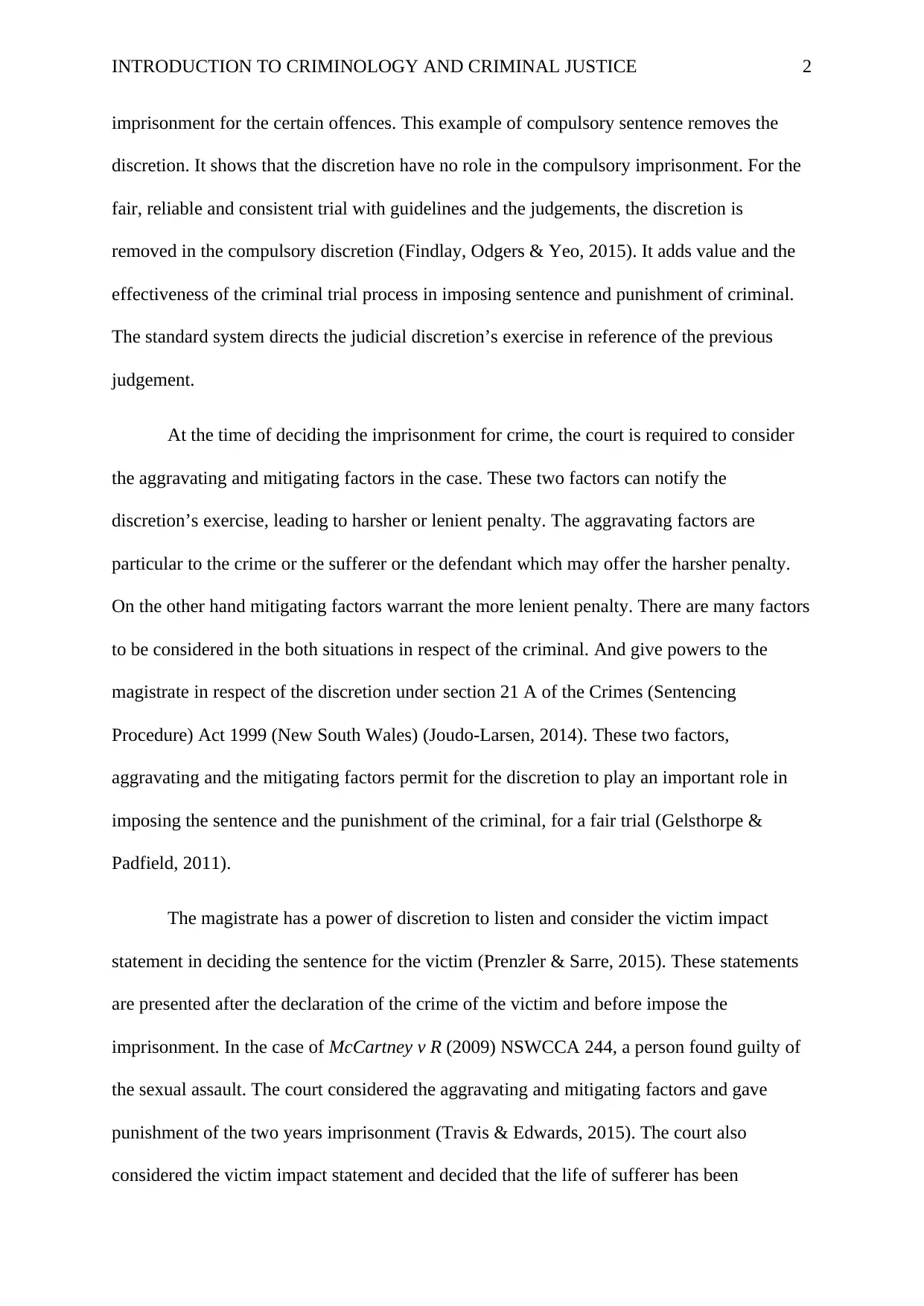
INTRODUCTION TO CRIMINOLOGY AND CRIMINAL JUSTICE 2
imprisonment for the certain offences. This example of compulsory sentence removes the
discretion. It shows that the discretion have no role in the compulsory imprisonment. For the
fair, reliable and consistent trial with guidelines and the judgements, the discretion is
removed in the compulsory discretion (Findlay, Odgers & Yeo, 2015). It adds value and the
effectiveness of the criminal trial process in imposing sentence and punishment of criminal.
The standard system directs the judicial discretion’s exercise in reference of the previous
judgement.
At the time of deciding the imprisonment for crime, the court is required to consider
the aggravating and mitigating factors in the case. These two factors can notify the
discretion’s exercise, leading to harsher or lenient penalty. The aggravating factors are
particular to the crime or the sufferer or the defendant which may offer the harsher penalty.
On the other hand mitigating factors warrant the more lenient penalty. There are many factors
to be considered in the both situations in respect of the criminal. And give powers to the
magistrate in respect of the discretion under section 21 A of the Crimes (Sentencing
Procedure) Act 1999 (New South Wales) (Joudo-Larsen, 2014). These two factors,
aggravating and the mitigating factors permit for the discretion to play an important role in
imposing the sentence and the punishment of the criminal, for a fair trial (Gelsthorpe &
Padfield, 2011).
The magistrate has a power of discretion to listen and consider the victim impact
statement in deciding the sentence for the victim (Prenzler & Sarre, 2015). These statements
are presented after the declaration of the crime of the victim and before impose the
imprisonment. In the case of McCartney v R (2009) NSWCCA 244, a person found guilty of
the sexual assault. The court considered the aggravating and mitigating factors and gave
punishment of the two years imprisonment (Travis & Edwards, 2015). The court also
considered the victim impact statement and decided that the life of sufferer has been
imprisonment for the certain offences. This example of compulsory sentence removes the
discretion. It shows that the discretion have no role in the compulsory imprisonment. For the
fair, reliable and consistent trial with guidelines and the judgements, the discretion is
removed in the compulsory discretion (Findlay, Odgers & Yeo, 2015). It adds value and the
effectiveness of the criminal trial process in imposing sentence and punishment of criminal.
The standard system directs the judicial discretion’s exercise in reference of the previous
judgement.
At the time of deciding the imprisonment for crime, the court is required to consider
the aggravating and mitigating factors in the case. These two factors can notify the
discretion’s exercise, leading to harsher or lenient penalty. The aggravating factors are
particular to the crime or the sufferer or the defendant which may offer the harsher penalty.
On the other hand mitigating factors warrant the more lenient penalty. There are many factors
to be considered in the both situations in respect of the criminal. And give powers to the
magistrate in respect of the discretion under section 21 A of the Crimes (Sentencing
Procedure) Act 1999 (New South Wales) (Joudo-Larsen, 2014). These two factors,
aggravating and the mitigating factors permit for the discretion to play an important role in
imposing the sentence and the punishment of the criminal, for a fair trial (Gelsthorpe &
Padfield, 2011).
The magistrate has a power of discretion to listen and consider the victim impact
statement in deciding the sentence for the victim (Prenzler & Sarre, 2015). These statements
are presented after the declaration of the crime of the victim and before impose the
imprisonment. In the case of McCartney v R (2009) NSWCCA 244, a person found guilty of
the sexual assault. The court considered the aggravating and mitigating factors and gave
punishment of the two years imprisonment (Travis & Edwards, 2015). The court also
considered the victim impact statement and decided that the life of sufferer has been
⊘ This is a preview!⊘
Do you want full access?
Subscribe today to unlock all pages.

Trusted by 1+ million students worldwide
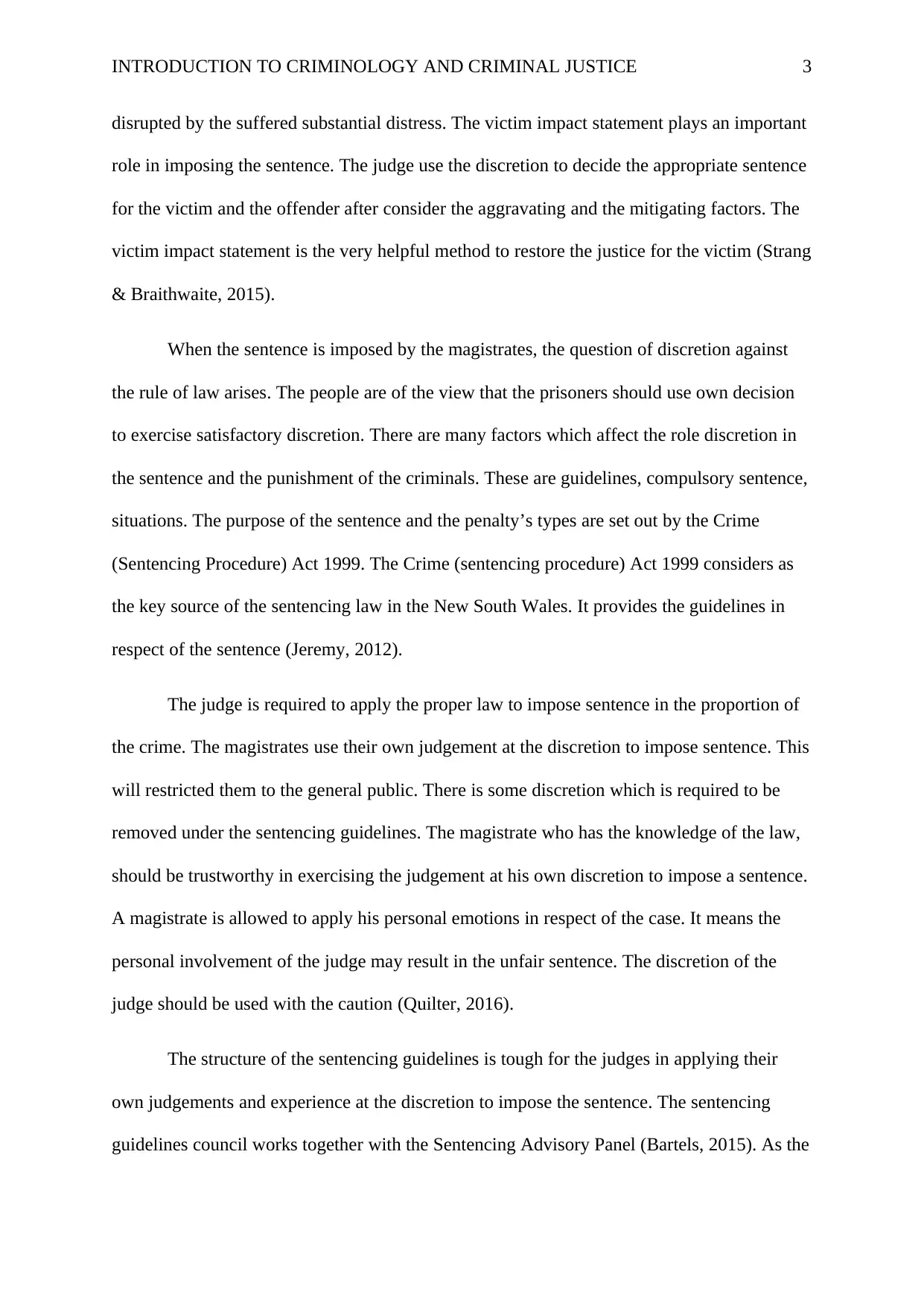
INTRODUCTION TO CRIMINOLOGY AND CRIMINAL JUSTICE 3
disrupted by the suffered substantial distress. The victim impact statement plays an important
role in imposing the sentence. The judge use the discretion to decide the appropriate sentence
for the victim and the offender after consider the aggravating and the mitigating factors. The
victim impact statement is the very helpful method to restore the justice for the victim (Strang
& Braithwaite, 2015).
When the sentence is imposed by the magistrates, the question of discretion against
the rule of law arises. The people are of the view that the prisoners should use own decision
to exercise satisfactory discretion. There are many factors which affect the role discretion in
the sentence and the punishment of the criminals. These are guidelines, compulsory sentence,
situations. The purpose of the sentence and the penalty’s types are set out by the Crime
(Sentencing Procedure) Act 1999. The Crime (sentencing procedure) Act 1999 considers as
the key source of the sentencing law in the New South Wales. It provides the guidelines in
respect of the sentence (Jeremy, 2012).
The judge is required to apply the proper law to impose sentence in the proportion of
the crime. The magistrates use their own judgement at the discretion to impose sentence. This
will restricted them to the general public. There is some discretion which is required to be
removed under the sentencing guidelines. The magistrate who has the knowledge of the law,
should be trustworthy in exercising the judgement at his own discretion to impose a sentence.
A magistrate is allowed to apply his personal emotions in respect of the case. It means the
personal involvement of the judge may result in the unfair sentence. The discretion of the
judge should be used with the caution (Quilter, 2016).
The structure of the sentencing guidelines is tough for the judges in applying their
own judgements and experience at the discretion to impose the sentence. The sentencing
guidelines council works together with the Sentencing Advisory Panel (Bartels, 2015). As the
disrupted by the suffered substantial distress. The victim impact statement plays an important
role in imposing the sentence. The judge use the discretion to decide the appropriate sentence
for the victim and the offender after consider the aggravating and the mitigating factors. The
victim impact statement is the very helpful method to restore the justice for the victim (Strang
& Braithwaite, 2015).
When the sentence is imposed by the magistrates, the question of discretion against
the rule of law arises. The people are of the view that the prisoners should use own decision
to exercise satisfactory discretion. There are many factors which affect the role discretion in
the sentence and the punishment of the criminals. These are guidelines, compulsory sentence,
situations. The purpose of the sentence and the penalty’s types are set out by the Crime
(Sentencing Procedure) Act 1999. The Crime (sentencing procedure) Act 1999 considers as
the key source of the sentencing law in the New South Wales. It provides the guidelines in
respect of the sentence (Jeremy, 2012).
The judge is required to apply the proper law to impose sentence in the proportion of
the crime. The magistrates use their own judgement at the discretion to impose sentence. This
will restricted them to the general public. There is some discretion which is required to be
removed under the sentencing guidelines. The magistrate who has the knowledge of the law,
should be trustworthy in exercising the judgement at his own discretion to impose a sentence.
A magistrate is allowed to apply his personal emotions in respect of the case. It means the
personal involvement of the judge may result in the unfair sentence. The discretion of the
judge should be used with the caution (Quilter, 2016).
The structure of the sentencing guidelines is tough for the judges in applying their
own judgements and experience at the discretion to impose the sentence. The sentencing
guidelines council works together with the Sentencing Advisory Panel (Bartels, 2015). As the
Paraphrase This Document
Need a fresh take? Get an instant paraphrase of this document with our AI Paraphraser
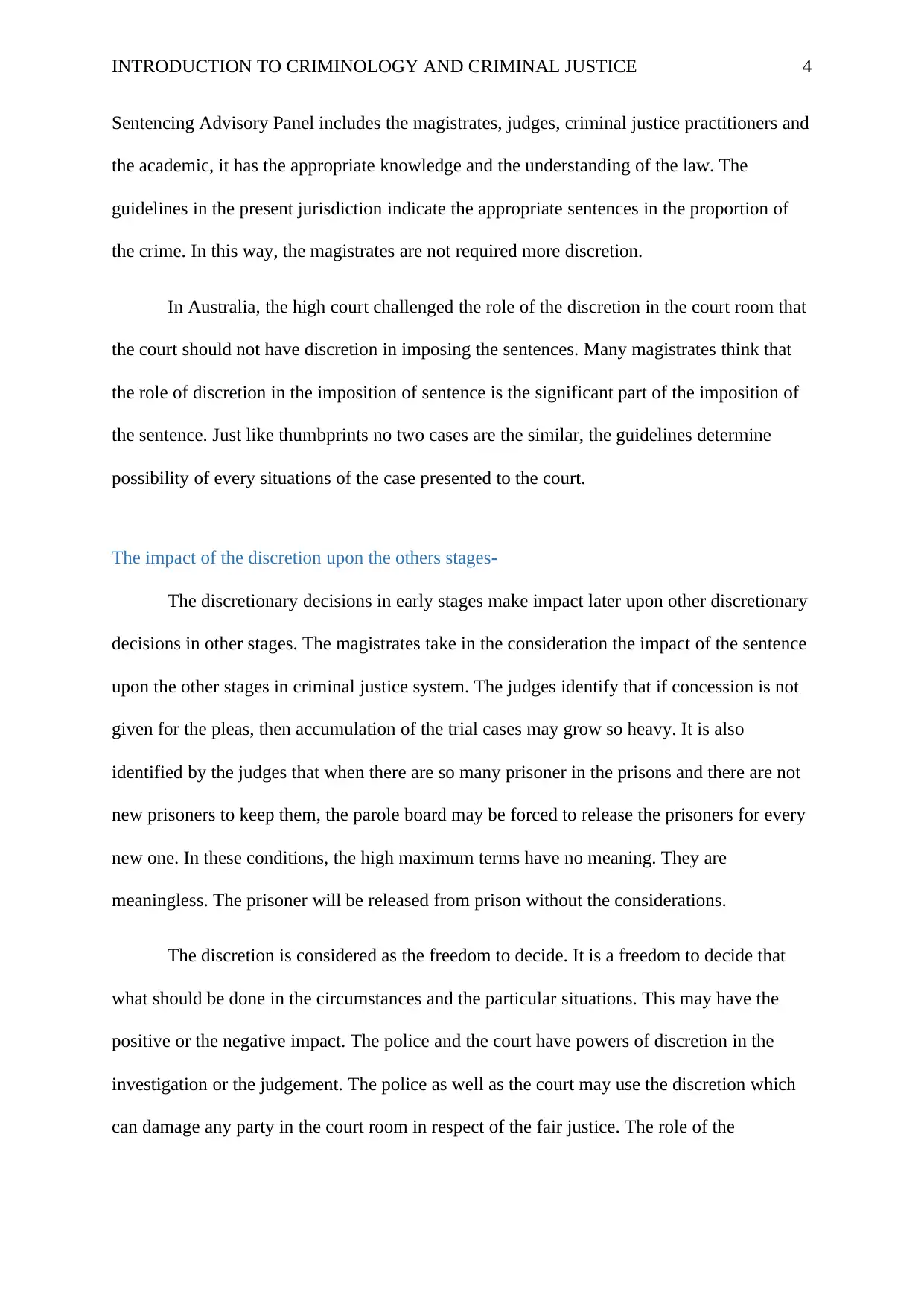
INTRODUCTION TO CRIMINOLOGY AND CRIMINAL JUSTICE 4
Sentencing Advisory Panel includes the magistrates, judges, criminal justice practitioners and
the academic, it has the appropriate knowledge and the understanding of the law. The
guidelines in the present jurisdiction indicate the appropriate sentences in the proportion of
the crime. In this way, the magistrates are not required more discretion.
In Australia, the high court challenged the role of the discretion in the court room that
the court should not have discretion in imposing the sentences. Many magistrates think that
the role of discretion in the imposition of sentence is the significant part of the imposition of
the sentence. Just like thumbprints no two cases are the similar, the guidelines determine
possibility of every situations of the case presented to the court.
The impact of the discretion upon the others stages-
The discretionary decisions in early stages make impact later upon other discretionary
decisions in other stages. The magistrates take in the consideration the impact of the sentence
upon the other stages in criminal justice system. The judges identify that if concession is not
given for the pleas, then accumulation of the trial cases may grow so heavy. It is also
identified by the judges that when there are so many prisoner in the prisons and there are not
new prisoners to keep them, the parole board may be forced to release the prisoners for every
new one. In these conditions, the high maximum terms have no meaning. They are
meaningless. The prisoner will be released from prison without the considerations.
The discretion is considered as the freedom to decide. It is a freedom to decide that
what should be done in the circumstances and the particular situations. This may have the
positive or the negative impact. The police and the court have powers of discretion in the
investigation or the judgement. The police as well as the court may use the discretion which
can damage any party in the court room in respect of the fair justice. The role of the
Sentencing Advisory Panel includes the magistrates, judges, criminal justice practitioners and
the academic, it has the appropriate knowledge and the understanding of the law. The
guidelines in the present jurisdiction indicate the appropriate sentences in the proportion of
the crime. In this way, the magistrates are not required more discretion.
In Australia, the high court challenged the role of the discretion in the court room that
the court should not have discretion in imposing the sentences. Many magistrates think that
the role of discretion in the imposition of sentence is the significant part of the imposition of
the sentence. Just like thumbprints no two cases are the similar, the guidelines determine
possibility of every situations of the case presented to the court.
The impact of the discretion upon the others stages-
The discretionary decisions in early stages make impact later upon other discretionary
decisions in other stages. The magistrates take in the consideration the impact of the sentence
upon the other stages in criminal justice system. The judges identify that if concession is not
given for the pleas, then accumulation of the trial cases may grow so heavy. It is also
identified by the judges that when there are so many prisoner in the prisons and there are not
new prisoners to keep them, the parole board may be forced to release the prisoners for every
new one. In these conditions, the high maximum terms have no meaning. They are
meaningless. The prisoner will be released from prison without the considerations.
The discretion is considered as the freedom to decide. It is a freedom to decide that
what should be done in the circumstances and the particular situations. This may have the
positive or the negative impact. The police and the court have powers of discretion in the
investigation or the judgement. The police as well as the court may use the discretion which
can damage any party in the court room in respect of the fair justice. The role of the
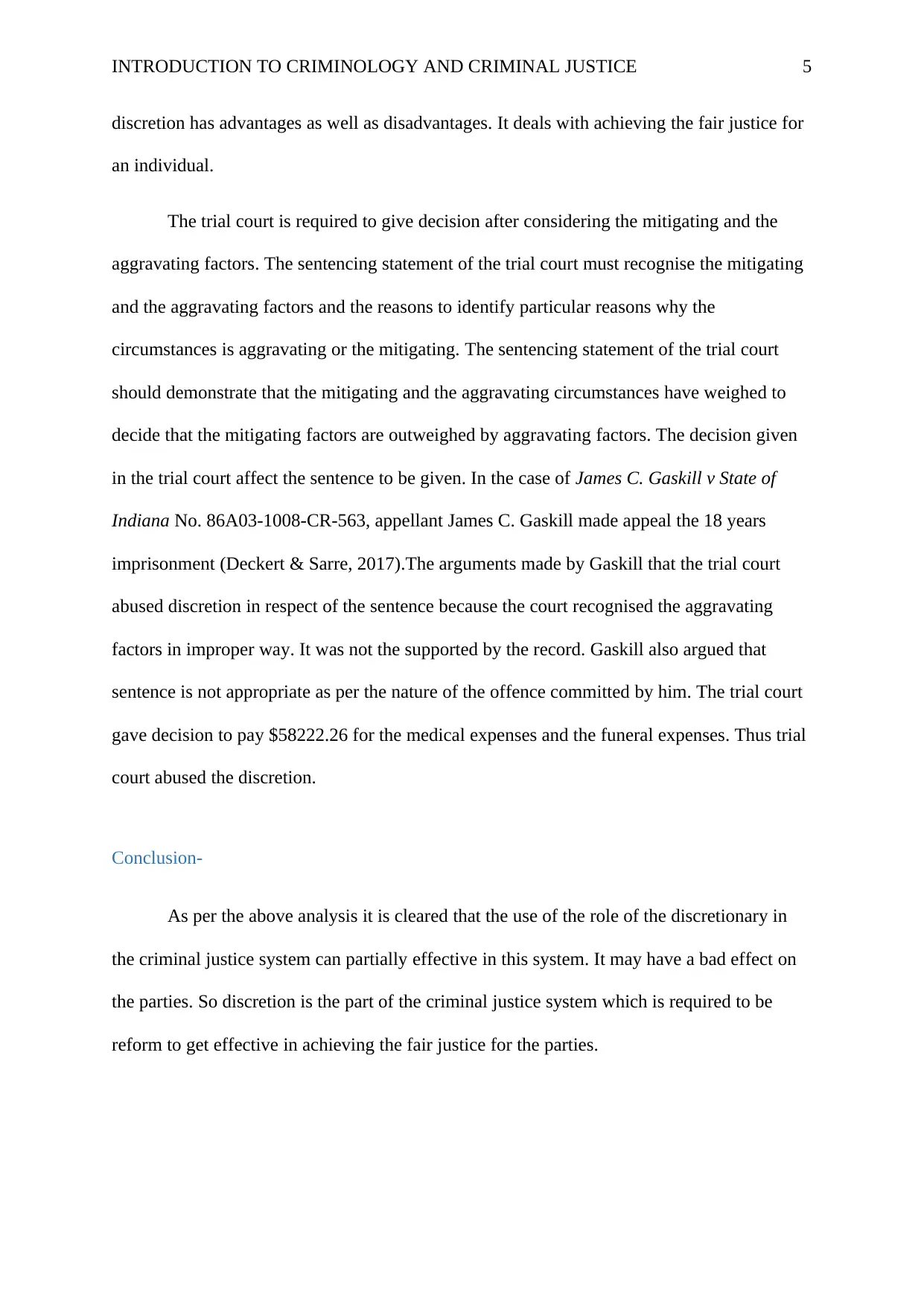
INTRODUCTION TO CRIMINOLOGY AND CRIMINAL JUSTICE 5
discretion has advantages as well as disadvantages. It deals with achieving the fair justice for
an individual.
The trial court is required to give decision after considering the mitigating and the
aggravating factors. The sentencing statement of the trial court must recognise the mitigating
and the aggravating factors and the reasons to identify particular reasons why the
circumstances is aggravating or the mitigating. The sentencing statement of the trial court
should demonstrate that the mitigating and the aggravating circumstances have weighed to
decide that the mitigating factors are outweighed by aggravating factors. The decision given
in the trial court affect the sentence to be given. In the case of James C. Gaskill v State of
Indiana No. 86A03-1008-CR-563, appellant James C. Gaskill made appeal the 18 years
imprisonment (Deckert & Sarre, 2017).The arguments made by Gaskill that the trial court
abused discretion in respect of the sentence because the court recognised the aggravating
factors in improper way. It was not the supported by the record. Gaskill also argued that
sentence is not appropriate as per the nature of the offence committed by him. The trial court
gave decision to pay $58222.26 for the medical expenses and the funeral expenses. Thus trial
court abused the discretion.
Conclusion-
As per the above analysis it is cleared that the use of the role of the discretionary in
the criminal justice system can partially effective in this system. It may have a bad effect on
the parties. So discretion is the part of the criminal justice system which is required to be
reform to get effective in achieving the fair justice for the parties.
discretion has advantages as well as disadvantages. It deals with achieving the fair justice for
an individual.
The trial court is required to give decision after considering the mitigating and the
aggravating factors. The sentencing statement of the trial court must recognise the mitigating
and the aggravating factors and the reasons to identify particular reasons why the
circumstances is aggravating or the mitigating. The sentencing statement of the trial court
should demonstrate that the mitigating and the aggravating circumstances have weighed to
decide that the mitigating factors are outweighed by aggravating factors. The decision given
in the trial court affect the sentence to be given. In the case of James C. Gaskill v State of
Indiana No. 86A03-1008-CR-563, appellant James C. Gaskill made appeal the 18 years
imprisonment (Deckert & Sarre, 2017).The arguments made by Gaskill that the trial court
abused discretion in respect of the sentence because the court recognised the aggravating
factors in improper way. It was not the supported by the record. Gaskill also argued that
sentence is not appropriate as per the nature of the offence committed by him. The trial court
gave decision to pay $58222.26 for the medical expenses and the funeral expenses. Thus trial
court abused the discretion.
Conclusion-
As per the above analysis it is cleared that the use of the role of the discretionary in
the criminal justice system can partially effective in this system. It may have a bad effect on
the parties. So discretion is the part of the criminal justice system which is required to be
reform to get effective in achieving the fair justice for the parties.
⊘ This is a preview!⊘
Do you want full access?
Subscribe today to unlock all pages.

Trusted by 1+ million students worldwide
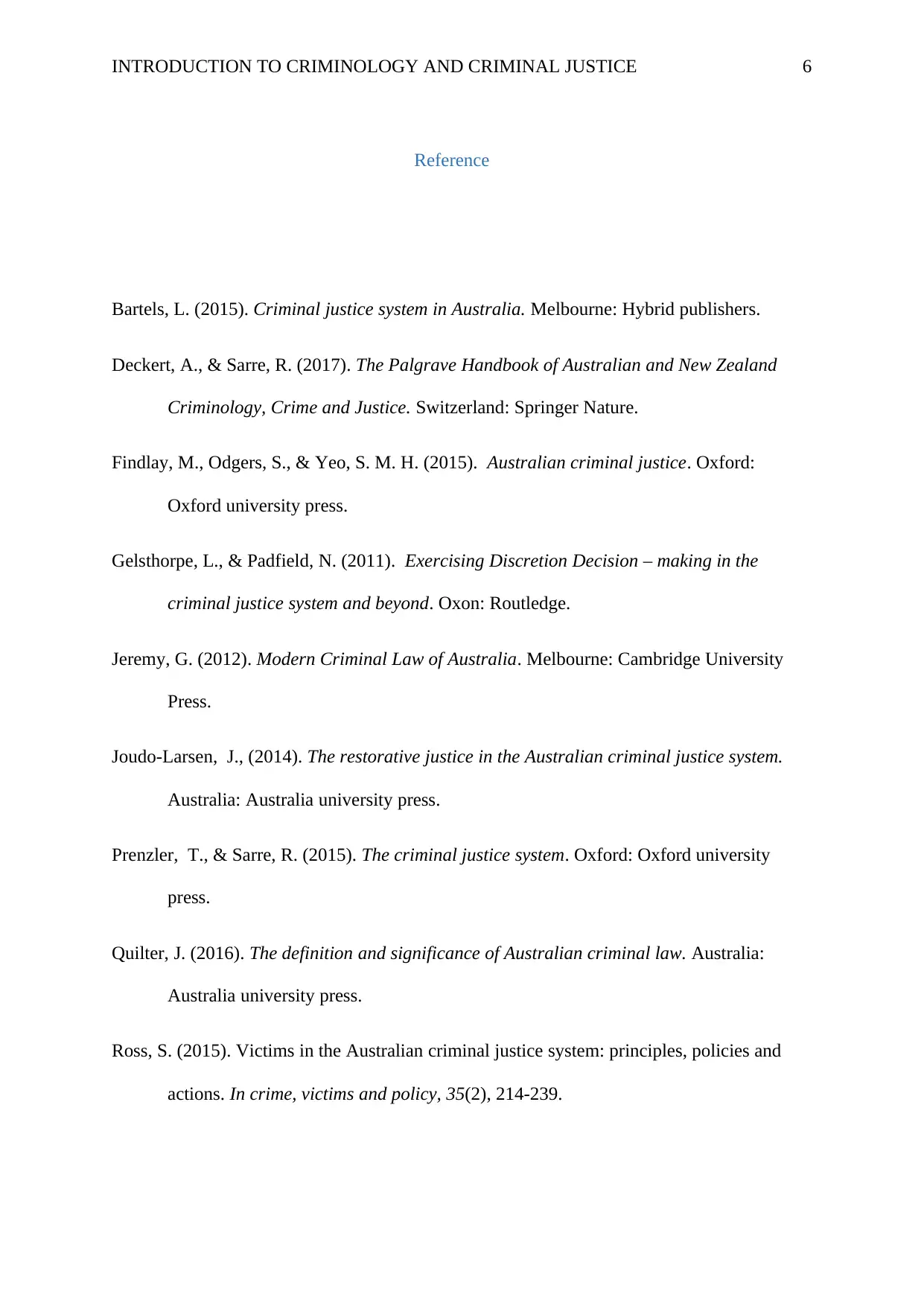
INTRODUCTION TO CRIMINOLOGY AND CRIMINAL JUSTICE 6
Reference
Bartels, L. (2015). Criminal justice system in Australia. Melbourne: Hybrid publishers.
Deckert, A., & Sarre, R. (2017). The Palgrave Handbook of Australian and New Zealand
Criminology, Crime and Justice. Switzerland: Springer Nature.
Findlay, M., Odgers, S., & Yeo, S. M. H. (2015). Australian criminal justice. Oxford:
Oxford university press.
Gelsthorpe, L., & Padfield, N. (2011). Exercising Discretion Decision – making in the
criminal justice system and beyond. Oxon: Routledge.
Jeremy, G. (2012). Modern Criminal Law of Australia. Melbourne: Cambridge University
Press.
Joudo-Larsen, J., (2014). The restorative justice in the Australian criminal justice system.
Australia: Australia university press.
Prenzler, T., & Sarre, R. (2015). The criminal justice system. Oxford: Oxford university
press.
Quilter, J. (2016). The definition and significance of Australian criminal law. Australia:
Australia university press.
Ross, S. (2015). Victims in the Australian criminal justice system: principles, policies and
actions. In crime, victims and policy, 35(2), 214-239.
Reference
Bartels, L. (2015). Criminal justice system in Australia. Melbourne: Hybrid publishers.
Deckert, A., & Sarre, R. (2017). The Palgrave Handbook of Australian and New Zealand
Criminology, Crime and Justice. Switzerland: Springer Nature.
Findlay, M., Odgers, S., & Yeo, S. M. H. (2015). Australian criminal justice. Oxford:
Oxford university press.
Gelsthorpe, L., & Padfield, N. (2011). Exercising Discretion Decision – making in the
criminal justice system and beyond. Oxon: Routledge.
Jeremy, G. (2012). Modern Criminal Law of Australia. Melbourne: Cambridge University
Press.
Joudo-Larsen, J., (2014). The restorative justice in the Australian criminal justice system.
Australia: Australia university press.
Prenzler, T., & Sarre, R. (2015). The criminal justice system. Oxford: Oxford university
press.
Quilter, J. (2016). The definition and significance of Australian criminal law. Australia:
Australia university press.
Ross, S. (2015). Victims in the Australian criminal justice system: principles, policies and
actions. In crime, victims and policy, 35(2), 214-239.
Paraphrase This Document
Need a fresh take? Get an instant paraphrase of this document with our AI Paraphraser

INTRODUCTION TO CRIMINOLOGY AND CRIMINAL JUSTICE 7
Strang, H., & Braithwaite, J. (2015). Restorative justice: philosophy to practice. Oxford:
Routledge.
Strange, C. (2011). Qualities of Mercy: Justice, Punishment, and Discretion. Vancouver:
UBC Press.
Travis, L. F., & Edwards, B. D. (2015). Introduction to Criminal Justice. Oxon: Routledge.
Strang, H., & Braithwaite, J. (2015). Restorative justice: philosophy to practice. Oxford:
Routledge.
Strange, C. (2011). Qualities of Mercy: Justice, Punishment, and Discretion. Vancouver:
UBC Press.
Travis, L. F., & Edwards, B. D. (2015). Introduction to Criminal Justice. Oxon: Routledge.
1 out of 8
Related Documents
Your All-in-One AI-Powered Toolkit for Academic Success.
+13062052269
info@desklib.com
Available 24*7 on WhatsApp / Email
![[object Object]](/_next/static/media/star-bottom.7253800d.svg)
Unlock your academic potential
Copyright © 2020–2025 A2Z Services. All Rights Reserved. Developed and managed by ZUCOL.


![LLB Criminal Law Case Study: R v Seed; R v Stark [2007] EWCA Crim 254](/_next/image/?url=https%3A%2F%2Fdesklib.com%2Fmedia%2Fimages%2Fzw%2F226637320389411aa1571119b4239a47.jpg&w=256&q=75)
